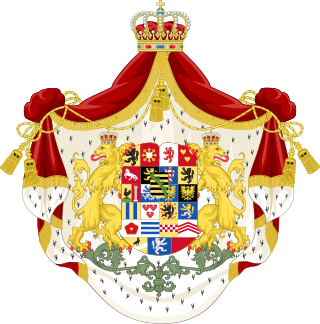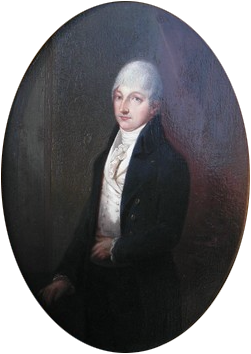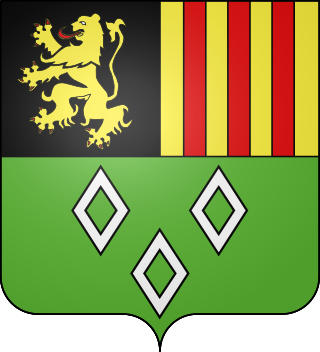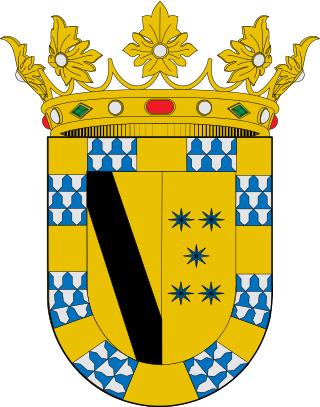
The House of Saxe-Coburg and Gotha is a European royal house. It takes its name from its oldest domain, the Ernestine duchy of Saxe-Coburg and Gotha, and its members later sat on the thrones of Belgium, Bulgaria, Portugal, and the United Kingdom and its dominions.

St. Maurus reliquary is a Romanesque reliquary exhibited in the castle of Bečov nad Teplou in the west of the Czech Republic. It is considered to be the second most important historical artifact in the Czech territory after the Czech Crown Jewels.

The Castle of Freÿr with its gardens in the style of Le Nôtre is located in Wallonia on the left bank of the Meuse, between Waulsort and Dinant. They form one of the most magnificent natural sites in Belgium. It has been classified as one of Wallonia's major heritage sites. It is often called a greatly reduced Versailles. Originally a Renaissance castle, it was extended in the 18th century and was once the residence of dukes and their royal guests. It has gardens including orange trees. The more than three-hundred-year-old orangeries are the oldest in the Low Countries.

Duke of Osuna is a Spanish noble title that was first awarded in 1562 by King Philip II of Spain to Pedro Girón de la Cueva,. Pedro was also Viceroy of Naples, (1582–1586), Ambassador in Portugal and 5th Count of Ureña.
The Belgian nobility comprises Belgian individuals or families recognized as noble with or without a title of nobility in the Kingdom of Belgium. The Belgian constitution states that no specific privileges are attached to the nobility.

The House of Ursel is the name of an old Belgian noble family of German origin. The Head of the House is styled as Duke of Ursel, while other members are styled as Count/Countess of Ursel.

Princess Rosemary of Salm-Salm was a member of the princely House of Salm-Salm. Through her marriage to Archduke Hubert Salvator of Austria, Rosemary was a member of the Tuscan line of the House of Habsburg-Lorraine.

The Florennes Castle in Florennes, Namur, Wallonia, Belgium, is a castle that dates back to the 9th century, although the most of the modern structure is much more recent.

Frédéric Auguste Alexandre de Beaufort-Spontin, 1st Duke of Beaufort-Spontin, was a member of the House of Beaufort-Spontin, a Belgian noble family that opposed Napoleon I of France.
Robert II of Namur was count of Namur from the death of his father in 1011 to some time between 1018 and 1031. He was the son of Albert I, and Ermengarde, daughter of Charles, Duke of Lower Lorraine.

Florennes Abbey is a former Benedictine monastery in Florennes, province of Namur, Wallonia, Belgium. The abbey was founded in the 11th century, but has left very few visible remains.

The House of Glymes was an old Belgian noble family, an illegitimate branch of the House of Reginarid, which ruled the Duchy of Brabant. Glymes or Glimes is a municipality of Incourt. Their descendants of the branch of Grimberghen are styled as the Prince de Grimberghen.
Lord Chamberlain of the Archduchess was a ceremonial function at the imperial court of Brussels.
Events in the year 1851 in Belgium.

Count of Villada is a hereditary title in the peerage of Spain, granted in 1625 by Philip IV to Enrique Pimentel, a Spanish statesman who was son of the 2nd Marquess of Távara.

Antoine Guillaume Joseph Gaston, comte Errembault de Dudzeele was a Belgian diplomat.
Charles Julien Isidore de Stein d'Altenstein (1819–1896) was a civil servant in the Belgian ministry of foreign affairs, with a particular interest in heraldry and genealogy. He was born in Mesnil-Saint-Blaise (Houyet), the second son of Charles Frédéric Guillaume, baron Stein d'Altenstein, and Marie-Catherine de Malmédy de Deignée. His father's family was originally from Germany. He married Justine Lysen (1827–1860), with whom he had three children, Julien, Armand and Clotilde.

Duke of Lerma is a hereditary title in the Peerage of Spain accompanied by the dignity of Grandee, granted in 1599 by Philip III to Francisco Gómez de Sandoval, 4th Count of Lerma and his royal favourite.

Prince Ludwig Joseph Maximilian von Starhemberg was an Austrian diplomat and since 1802 Knight of the Order of the Golden Fleece.


















